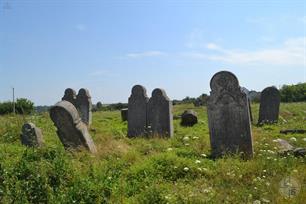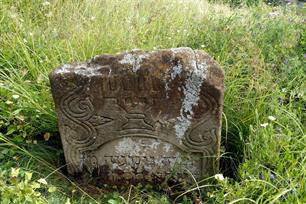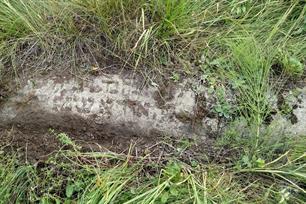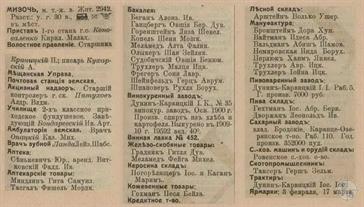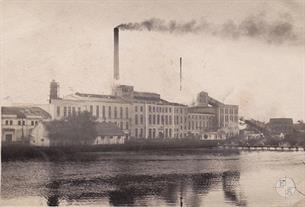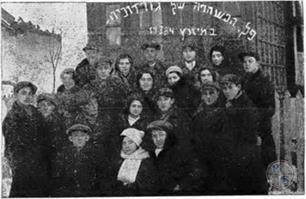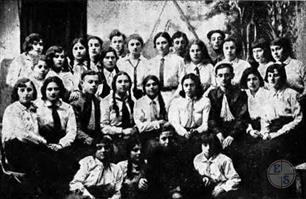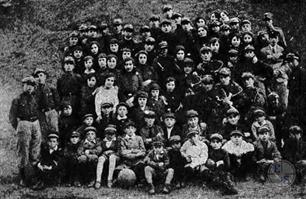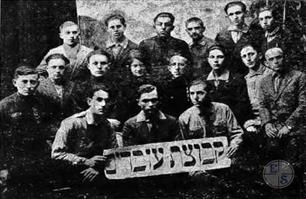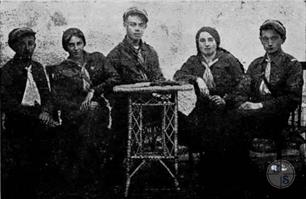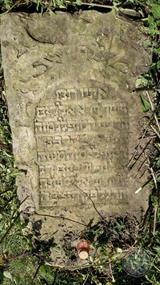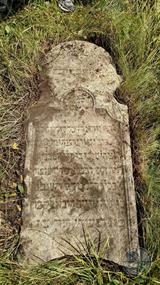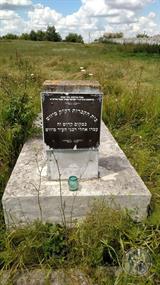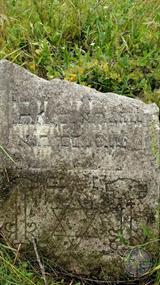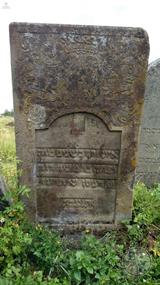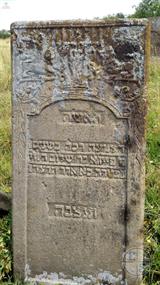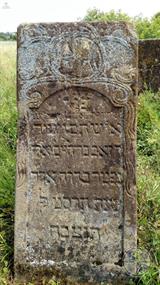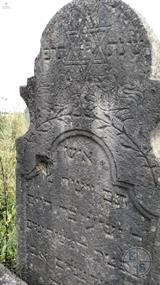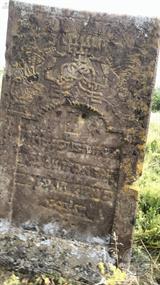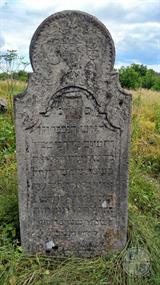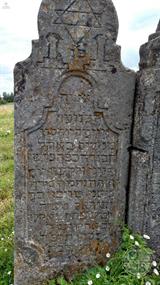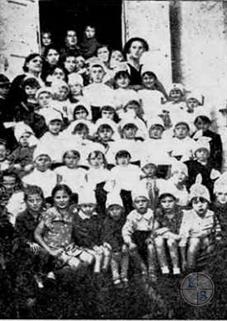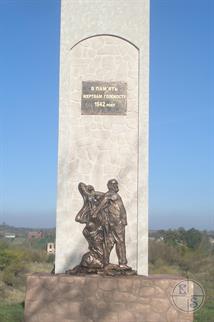Mizoch
Rivne district, Rivne region
Sources:
- Jewish encyclopedia of Brockhaus & Efron;
- Russian Jewish encyclopedia. Translated from Russian by Eugene Snaider;
- The All South-Western Territory: reference and address book of the Kyiv, Podolsk and Volyn provinces. Printing house L.M. Fish and P.E. Wolfson, 1913;
- Yad Vashem. Mizocz;
- Asher Gilberg. Mizoch – its Life and its Annihilation, [in:] Memorial book of Mizocz. Tel-Aviv, 1961. Translated from Hebrew by Yonatan Altman–Shafer
Photo:
- European Jewish Cemeteries Initiative. Mizoch Jewish Cemetery;
- Biblioteka Narodowa Polona. Mizocz
- Center for Jewish Art. Mizoch (Мізоч)
- Roman Mykhalchuk. Mizoch on the Holocaust map
- Mizocz - sefer zikaron (Memorial book of Mizocz). Tel-Aviv, 1961
- Jewish encyclopedia of Brockhaus & Efron;
- Russian Jewish encyclopedia. Translated from Russian by Eugene Snaider;
- The All South-Western Territory: reference and address book of the Kyiv, Podolsk and Volyn provinces. Printing house L.M. Fish and P.E. Wolfson, 1913;
- Yad Vashem. Mizocz;
- Asher Gilberg. Mizoch – its Life and its Annihilation, [in:] Memorial book of Mizocz. Tel-Aviv, 1961. Translated from Hebrew by Yonatan Altman–Shafer
Photo:
- European Jewish Cemeteries Initiative. Mizoch Jewish Cemetery;
- Biblioteka Narodowa Polona. Mizocz
- Center for Jewish Art. Mizoch (Мізоч)
- Roman Mykhalchuk. Mizoch on the Holocaust map
- Mizocz - sefer zikaron (Memorial book of Mizocz). Tel-Aviv, 1961
Mizoch (ukr. Мізоч, rus. Мизоч), a city-type settlement (since 1940), known since 1322. In the 16–18 centuries - in the Volyn Voivodeship as part of the Commonwealth. Since 1793 - as part of the Russian Empire. In the 19th - beginning of the 20th century - the township of Dubno district of the Volyn province. In 1919–39 - in the Volyn Voivodeship as part of Poland, in 1939–91 - as part of the Ukrainian SSR.
In 1784, 37 Jews lived in Mizoch,
in 1787 - 86,
in 1847 - 678,
in 1897 - 1175 (44%),
in 1921 - 882,
In mid -1941 - 1048 Jews.
In 1784, 37 Jews lived in Mizoch,
in 1787 - 86,
in 1847 - 678,
in 1897 - 1175 (44%),
in 1921 - 882,
In mid -1941 - 1048 Jews.
In 1774, the Jews of Mizoch received permission to build a synagogue.
The main classes of the Jewish population in the 19th - early 20th centuries are crafts and trade.
In the middle of the 19th century Jews owned a brewery and a leather plant. Soon Jewish industrialist Abram Horenstein built a large sugar factory on the northeastern edge of the town, and next to the sugar factory, a farm for fattening cattle with beet waste.
At first, the sugar factory employed few Jews and only in clerical positions, but over time, thanks to the influence of Zionist youth movements, their numbers increased to many tens who worked in all departments.
In 1895, Brodsky entrepreneurs bought a sugar factory in Mizoch.
The count Karwitzky set up a factory for beer and a large flour mill, and the Jew Isaac Braz set up a factory for coarse woolen fabrics for the farmers. Thanks to the sugar factory, a track was laid for a train that connected Mizoch to the larger world via the Kyiv–Lviv railway line. Apart from these, many workshops and small industries were established, such as: the oil press houses of Avraham Bronstein, Bozai Mizoch, Temah Berman, and other smaller ones; two sawmills belonging to Kaput and Meizlich; a dairy belonging to Meir Braz; and many workshops of all kinds.
In 1914, Jews owned both pharmacy warehouses, only kerosene warehouse, only forest warehouse, 1 of 2 beer warehouses and all 21 shops in Mizoch.
The only cattle-dealer was also a Jew Hersh Takser.
The Jew Leyzer Landa was the only dentist in the township.
During the 1st World War, many Jews left for large cities.
The main classes of the Jewish population in the 19th - early 20th centuries are crafts and trade.
In the middle of the 19th century Jews owned a brewery and a leather plant. Soon Jewish industrialist Abram Horenstein built a large sugar factory on the northeastern edge of the town, and next to the sugar factory, a farm for fattening cattle with beet waste.
At first, the sugar factory employed few Jews and only in clerical positions, but over time, thanks to the influence of Zionist youth movements, their numbers increased to many tens who worked in all departments.
In 1895, Brodsky entrepreneurs bought a sugar factory in Mizoch.
The count Karwitzky set up a factory for beer and a large flour mill, and the Jew Isaac Braz set up a factory for coarse woolen fabrics for the farmers. Thanks to the sugar factory, a track was laid for a train that connected Mizoch to the larger world via the Kyiv–Lviv railway line. Apart from these, many workshops and small industries were established, such as: the oil press houses of Avraham Bronstein, Bozai Mizoch, Temah Berman, and other smaller ones; two sawmills belonging to Kaput and Meizlich; a dairy belonging to Meir Braz; and many workshops of all kinds.
In 1914, Jews owned both pharmacy warehouses, only kerosene warehouse, only forest warehouse, 1 of 2 beer warehouses and all 21 shops in Mizoch.
The only cattle-dealer was also a Jew Hersh Takser.
The Jew Leyzer Landa was the only dentist in the township.
During the 1st World War, many Jews left for large cities.
In 1917, the first Jewish library was opened in Mizoch.
In the 1920-30s. Mizoch acted branches of various Jewish parties and organizations. Mizoch's community had a "Tarbut" Zionist-oriented Hebrew-language network of educational institutions, including a kindergarten (opened in 1929). There were also Polish, Yiddish, and Hebrew public libraries.
Branches of Zionist parties and youth movements (such as Gordonia, Beitar, and Hashomer Hatzair) were also active in Mizocz.
With the help of the Joint, a mutual assistance cashbox and the branch of the Warsaw Jewish Cooperative Bank were opened.
3 synagogues acted in Mizoch: a beit midrash, the kloyz of the Trisk Hasidim, and the big synagogue. Next to this last one was a small house of worship, intended for Mincha and Ma'ariv during weekdays for worshippers of the big synagogue, although over time it became an independent house of worship.
Most Mizoch Jews were Trisk Hasids.
In the 1930s, the rabbi was Mikhl-Zvi Lerner, then - his son Nosn-Note, who died during the Holocaust.
After September 17, 1939, with the arrival of the Red Army, following the Ribbentrop-Molotov Pact, Mizoch became part of Soviet Ukraine. By June 1941 the town's Jewish population had increased to more than 2,000, including a number of refugees from the German-occupied part of Poland. Many of the newcomers, however, were deported to the Soviet interior.
On June 22, 1941 when the Germans invaded the Soviet Union, some 300 members of the Mizoch Jewish community succeeded in heading eastward, either as Red Army recruits or as evacuees and fugitives.
In the 1920-30s. Mizoch acted branches of various Jewish parties and organizations. Mizoch's community had a "Tarbut" Zionist-oriented Hebrew-language network of educational institutions, including a kindergarten (opened in 1929). There were also Polish, Yiddish, and Hebrew public libraries.
Branches of Zionist parties and youth movements (such as Gordonia, Beitar, and Hashomer Hatzair) were also active in Mizocz.
With the help of the Joint, a mutual assistance cashbox and the branch of the Warsaw Jewish Cooperative Bank were opened.
3 synagogues acted in Mizoch: a beit midrash, the kloyz of the Trisk Hasidim, and the big synagogue. Next to this last one was a small house of worship, intended for Mincha and Ma'ariv during weekdays for worshippers of the big synagogue, although over time it became an independent house of worship.
Most Mizoch Jews were Trisk Hasids.
In the 1930s, the rabbi was Mikhl-Zvi Lerner, then - his son Nosn-Note, who died during the Holocaust.
After September 17, 1939, with the arrival of the Red Army, following the Ribbentrop-Molotov Pact, Mizoch became part of Soviet Ukraine. By June 1941 the town's Jewish population had increased to more than 2,000, including a number of refugees from the German-occupied part of Poland. Many of the newcomers, however, were deported to the Soviet interior.
On June 22, 1941 when the Germans invaded the Soviet Union, some 300 members of the Mizoch Jewish community succeeded in heading eastward, either as Red Army recruits or as evacuees and fugitives.
The Germans captured the town on June 27, 1941. Two days later the Ukrainians carried out a week-long pogrom, that included the killing of several local Jews. Almost immediately after their entry, the Germans started enforcing a curfew and Jews were ordered to wear white armbands with a blue Star of David (replaced later by yellow patches) to be worn on the chest and on the back.
Jews had to step off sidewalks when encountering a German and Jewish men had to take off their hats.
The Germans established a Ukrainian auxiliary police force headed by a man named Mizoczyk. During the same period, a Judenrat (Jewish council) was established with former mayor Aba Shtivl as its head, as well as a Jewish police force headed by Goldbrener.
In the summer and fall of 1941 the Jewish police helped collect money, valuables, and other items demanded by the Germans as "contributions." From the very beginning of the occupation Jews had to perform forced labor, such as washing wounded soldier's laundry, snow removal, farm work, and construction work in the nearby town of Zdołbunуw for the German firm Josef Jung from Solingen.
Jews had to step off sidewalks when encountering a German and Jewish men had to take off their hats.
The Germans established a Ukrainian auxiliary police force headed by a man named Mizoczyk. During the same period, a Judenrat (Jewish council) was established with former mayor Aba Shtivl as its head, as well as a Jewish police force headed by Goldbrener.
In the summer and fall of 1941 the Jewish police helped collect money, valuables, and other items demanded by the Germans as "contributions." From the very beginning of the occupation Jews had to perform forced labor, such as washing wounded soldier's laundry, snow removal, farm work, and construction work in the nearby town of Zdołbunуw for the German firm Josef Jung from Solingen.
Apparently in March 1942. the Gebietskommissar (regional commissar) of the nearby town of Zdołbunуw announced that a ghetto would be established in Mizocz. All Jews from the town and the surrounding villages were ordered to move into the ghetto, located in the old part of the town; the actual transfer was probably not completed until June. This was an open ghetto, not surrounded by a wall or other physical barrier and it was not closely guarded. Despite the public hanging of Zeyde Gelman for illegal slaughtering, and several other arrests, the German administration of Mizocz was relatively benign.
On the morning of October 14, 1942, after a German murder squad arrived in the town, the organizers of the resistance movement and some other inmates of the ghetto set many houses in the ghetto on fire and attacked the Germans and Ukrainian auxiliary police. The fire helped a large number of people to escape, though about 200 people died in the flames in the ghetto.
Some Jews were apparently discovered in hiding places. Later on the same day, most of the remaining Jews of Mizocz (mainly women, children, and the elderly) were shot to death by an SD unit at the ravine near the sugar factory outside the town. The murder operation continued on October 15 since many of those who had escaped from the ghetto were caught and shot to death near the sugar factory. The few survivors took to the forests.
On the morning of October 14, 1942, after a German murder squad arrived in the town, the organizers of the resistance movement and some other inmates of the ghetto set many houses in the ghetto on fire and attacked the Germans and Ukrainian auxiliary police. The fire helped a large number of people to escape, though about 200 people died in the flames in the ghetto.
Some Jews were apparently discovered in hiding places. Later on the same day, most of the remaining Jews of Mizocz (mainly women, children, and the elderly) were shot to death by an SD unit at the ravine near the sugar factory outside the town. The murder operation continued on October 15 since many of those who had escaped from the ghetto were caught and shot to death near the sugar factory. The few survivors took to the forests.

- Home
- Shtetls
- Vinnytsia region
- Volyn region
- Dnipro region
- Donetsk region
- Zhytomyr region
- Zakarpattia region
- Zaporizhzhia region
- Ivano-Frankivsk region
- Kyiv region
- Kropyvnytskyi region
- Luhansk region
- Lviv region
- Mykolayiv region
- Odessa region
- Poltava region
- Rivne region
- Sumy region
- Ternopil region
- Kharkiv region
- Kherson region
- Khmelnytskyi region
- Chernihiv region
- Chernivtsi region
- Cherkasy region
- Crimea
- Synagogues
- Cemeteries
- Objects & guides
- Old photos
- History
- Contact
Jewish towns of Ukraine
My shtetl
My shtetl
Donate
Jewish towns of Ukraine
